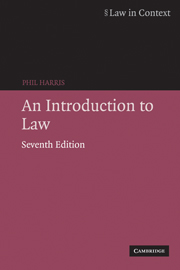Book contents
- Frontmatter
- Contents
- Preface
- Table of statutes
- Table of cases
- 1 Law and society
- 2 Law and morality
- 3 Law and the regulation of economic activity
- 4 Some important legal concepts
- 5 Law and property
- 6 Law and the settlement of disputes
- 7 The making of legal rules
- 8 The European dimension of English law
- 9 Liability in English law: the law of tort
- 10 Liability in English law: crime and the criminal justice system
- 11 The development and the role of the contract
- 12 Law and government
- 13 The legal profession
- 14 The judges
- Index
3 - Law and the regulation of economic activity
- Frontmatter
- Contents
- Preface
- Table of statutes
- Table of cases
- 1 Law and society
- 2 Law and morality
- 3 Law and the regulation of economic activity
- 4 Some important legal concepts
- 5 Law and property
- 6 Law and the settlement of disputes
- 7 The making of legal rules
- 8 The European dimension of English law
- 9 Liability in English law: the law of tort
- 10 Liability in English law: crime and the criminal justice system
- 11 The development and the role of the contract
- 12 Law and government
- 13 The legal profession
- 14 The judges
- Index
Summary
It is a commonplace assertion that the last hundred years have witnessed state intervention, especially in affairs involving economic activity, on a scale greater than at any other period in history. In chapter 1 we noted some examples of this phenomenon and discussed some of its basic aspects. But if we now pursue the matter, and ask exactly what is meant by the term ‘state intervention’, we find that this expansion of intervention has not come about in a straightforward fashion but has occurred through complex changes in the structure of society and the economy, and in the very nature and role of the state itself. As we shall see presently, the notion of ‘the state’ is itself surrounded by problems of definition, and by controversy both as to the precise nature of the modern state and as to what the most appropriate role for the state should be in advanced capitalist society. Of course, state intervention is by no means confined to the economic sphere: the state has taken on a more active role with respect to many other areas of social life, such as public administration and the growth of what is usually termed the ‘welfare state’. We shall discuss these developments presently, but for the moment we examine some of the main issues concerning state regulation of economic activity – a sphere of social life which is central to the existence of any social group.
- Type
- Chapter
- Information
- An Introduction to Law , pp. 68 - 89Publisher: Cambridge University PressPrint publication year: 2006



